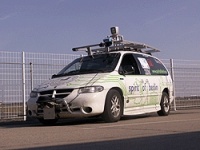Experimental system for car control is all in the mind
German computer scientists have developed a system making it possible to drive a car using thought control.

Researchers working on the AutoNOMOS Project at Freie Universität Berlin believe this level of autonomy could lead to safer motoring.
The AutoNOMOS so-called Brain Driver converts bioelectric brainwaves called electroencephalograms (EEG) into commands read by a computer-controlled vehicle.

Tests proved wave patterns read by head-mounted sensors could be interpreted as commands for direction, acceleration and braking.
For thoughts to produce a vehicle response the test subject must first train the computer to respond correctly.
He or she thinks of a individual situation for one of four commands — stop, start, left and right. The associated brain waves are then read by Brain Driver sensors and recorded by the car’s computer.
AutoNOMOS has proved when these thoughts are repeated the computer is able to prompt the correct response form the vehicle.
Brain commands are combined with a navigation map that recognises the road, other vehicles and pedestrians.
In practice, the computer can adhere to prescribed rules well, but situations requiring intuitive assessment are more difficult.
Register now to continue reading
Thanks for visiting The Engineer. You’ve now reached your monthly limit of news stories. Register for free to unlock unlimited access to all of our news coverage, as well as premium content including opinion, in-depth features and special reports.
Benefits of registering
-
In-depth insights and coverage of key emerging trends
-
Unrestricted access to special reports throughout the year
-
Daily technology news delivered straight to your inbox










Water Sector Talent Exodus Could Cripple The Sector
Maybe if things are essential for the running of a country and we want to pay a fair price we should be running these utilities on a not for profit...